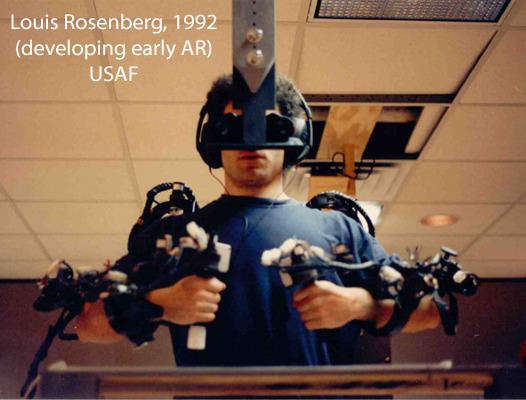 | ||
A virtual fixture is an overlay of augmented sensory information on a workspace in order to improve human performance in direct and remotely manipulated tasks. Developed in the early 1990s by Louis Rosenberg at the US Air Force, virtual fixtures was a pioneering platform in virtual reality and augmented reality technologies.
Contents
History
Virtual Fixtures was first developed by Louis Rosenberg in 1992 at the USAF Armstrong Labs, resulting in the first fully immersive Augmented Reality system ever built. Because 3D graphics were too slow in the early 1990s to present a photorealistic and spatially-registered augmented reality, Virtual Fixtures used two real physical robots, controlled by a full upper-body exoskeleton worn by the user. To create the immersive experience for the user, a unique optics configuration was employed that involved a pair of binocular magnifiers aligned so that the user’s view of the robot arms were brought forward so as to appear registered in the exact location of the user’s real physical arms. The result was a spatially-registered immersive experience in which the user moved his or her arms, while seeing robot arms in the place where his or her arms should be. The system also employed computer-generated virtual overlays in the form of simulated physical barriers, fields, and guides, designed to assist in the user while performing real physical tasks. Fitts Law performance testing was conducted on batteries of human test subjects, demonstrating for the first time, that a significant enhancement in human performance of real-world dexterous tasks could be achieved by providing immersive Augmented Reality overlays to users.
Concept
The concept of virtual fixtures was first introduced in (Rosenberg, 1992) as an overlay of virtual sensory information on a workspace in order to improve human performance in direct and remotely manipulated tasks. The virtual sensory overlays can be presented as physically realistic structures, registered in space such that they are perceived by the user to be fully present in the real workspace environment. The virtual sensory overlays can also be abstractions that have properties not possible of real physical structures. The concept of sensory overlays is difficult to visualize and talk about, as a consequence the virtual fixture metaphor was introduced. To understand what a virtual fixture is an analogy with a real physical fixture such as a ruler is often used. A simple task such as drawing a straight line on a piece of paper on free-hand is a task that most humans are unable to perform with good accuracy and high speed. However, the use of a simple device such as a ruler allows the task to be carried out fast and with good accuracy. The use of a ruler helps the user by guiding the pen along the ruler reducing the tremor and mental load of the user, thus increasing the quality of the task.
The definition of virtual fixtures in (Rosenberg) is much broader than simply providing guidance of the end-effector. For example, auditory virtual fixtures are used to increase the user awareness by providing audio clues that helps the user by providing multi modal cues for localization of the end-effector. Rosenberg argues that the success of virtual fixtures is not only because the user is guided by the fixture, but that the user experiences a greater presence and better localization in the remote workspace. However, in the context of human-machine collaborative systems, the term virtual fixtures is most often used to refer to a task dependent aid that guides the user's motion along desired directions while preventing motion in undesired directions or regions of the workspace. This is the type of virtual fixtures that is described in this article.
Virtual fixtures can be either guiding virtual fixtures or forbidden regions virtual fixtures. A forbidden regions virtual fixture could be used, for example, in a teleoperated setting where the operator has to drive a vehicle at a remote site to accomplish an objective. If there are pits at the remote site which would be harmful for the vehicle to fall into forbidden regions could be defined at the various pits locations, thus preventing the operator from issuing commands that would result in the vehicle ending up in such a pit.
Such illegal commands could easily be sent by an operator because of, for instance, delays in the teleoperation loop, poor telepresence or a number of other reasons.
An example of a guiding virtual fixture could be when the vehicle must follow a certain trajectory,
The operator is then able to control the progress along the preferred direction while motion along the non-preferred direction is constrained.
With both forbidden regions and guiding virtual fixtures the stiffness, or its inverse the compliance, of the fixture can be adjusted. If the compliance is high (low stiffness) the fixture is soft. On the other hand, when the compliance is zero (maximum stiffness) the fixture ishard.
Virtual Fixture Control Law
This section describes how a control law that implements virtual fixtures can be derived. It is assumed that the robot is a purely kinematic device with end-effector position
Thus the control signal
If
If the constant
To express more general constraints assume a time-varying matrix
If
where
If the input velocity is split into two components as:
it is possible to rewrite the control law as:
Next introduce a new compliance that affects only the non-preferred component of the velocity input and write the final control law as:
